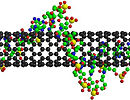3D internal structure of rechargeable batteries revealed for the first time
Lancaster University researchers have pioneered a technique to observe the 3D internal structure of rechargeable batteries for the first time.

Symbolic image
Computer-generated image
The research, published in Nature Communications, is led by Professor Oleg Kolosov from Lancaster’s Physics Department in collaboration with University College London and NEXGENNA Faraday Institution Consortium.
The team used a novel 3D Nano-Rheology Microscopy (3DNRM) -based technique to visualise the 3D nanostructure inside rechargeable batteries, from the molecular scale electrical double-layer to the nanoscale-thick electrochemical surface layer on the graphite anode surface in a lithium-ion battery.
For the first time, this enabled the direct observation of the progression of the whole three dimensional structure of the solid electric interface (SEI), a nanoscale passivation layer formed on the battery electrode-electrolyte interface, that predetermines key battery properties.
The authors were able to reveal key predictors of SEI layer formation in a complex interplay of molecular dimension electrical double layer structures, surface properties of carbon layers and solvent - Li ions interaction in the electrolyte.
The nanoarchitecture of solid-liquid interfaces are critical for high performance batteries, but it has been difficult to characterise reaction interfaces within batteries due to their inherent inaccessibility.
Dr Yue Chen of Lancaster University, who is the lead author, said: “So far, understanding the SEI formation mechanism is still a most challenging and least explored area due to the lack of an interfacial characterization technique capable of both nanoscale resolution and operation in the working battery environment.”
The dynamics of interfacial reactions define energy flow and conversion and govern chemical species transfer in important physical, chemical and biological processes, from catalytic reactions, energy storage and release in batteries, to antigen-antibody interactions and information transmission across neural cells.
This opens up a wide range of areas for the new technique from energy storage and chemical engineering to biomedical applications.
Most read news
Organizations
Other news from the department science

Get the analytics and lab tech industry in your inbox
By submitting this form you agree that LUMITOS AG will send you the newsletter(s) selected above by email. Your data will not be passed on to third parties. Your data will be stored and processed in accordance with our data protection regulations. LUMITOS may contact you by email for the purpose of advertising or market and opinion surveys. You can revoke your consent at any time without giving reasons to LUMITOS AG, Ernst-Augustin-Str. 2, 12489 Berlin, Germany or by e-mail at revoke@lumitos.com with effect for the future. In addition, each email contains a link to unsubscribe from the corresponding newsletter.




















































